|
Grumman F4F-4 Wildcat
Retooled
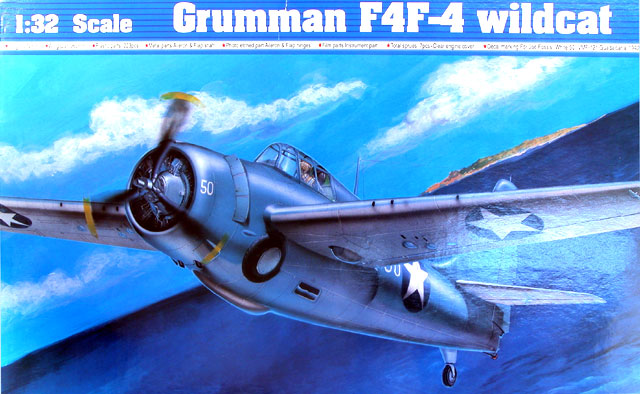
Trumpeter
S
u m m a r y
|
| Catalogue Number: |
02223 |
| Scale: |
1/32 |
| Contents and Media: |
223 parts in light grey and clear
injection molded plastic; metal shafts for ailerons and flaps; rubber
tires; photo-etched parts for control surface hinges; markings for one
aircraft |
| Price: |
suggested retail price USD$49.95 |
| Review Type: |
FirstLook |
| Advantages: |
Outline and appearance conforms to
published plans, photos and existing kits; high quality mouldings; adequate detail in most areas; ambitious workable
features including all control surfaces and wing folds; nicely detailed
cockpit parts including partial floor; rivet detail more restrained than
earlier version; thin, clear and accurate transparent parts. |
| Disadvantages: |
|
| Recommendation: |
Recommended. |
Previewed
by
Brett Green

HyperScale is proudly supported by Squadron.com
Back in February this year, Trumpeter released a new 1/32 scale
F4F-4 Wildcat in Asia as the first market in the global rollout of the kit.
The original version of this kit had some serious shape
problems, especially around the fuselage spine and nose. Before the kit was
introduced to the US market, the release was postponed to permit re-tooling of
the offending parts.
I have just received a test shot of Trumpeter's newly re-tooled
1/32 scale F4F-4 Wildcat.
It looks very good.
Trumpeter's re-tooled 1/32 scale F4F-4 Wildcat comprises 223 injection molded parts in grey plastic and clear styrene (including a clear cowl), rubber
tires, a small bag of metal rods, a photo-etched fret with hinges for control
surfaces and an acetate sheet with printed instruments.
The recessed rivets in the fuselage and the wings have been
toned down to a more subtle representation than in the original release.
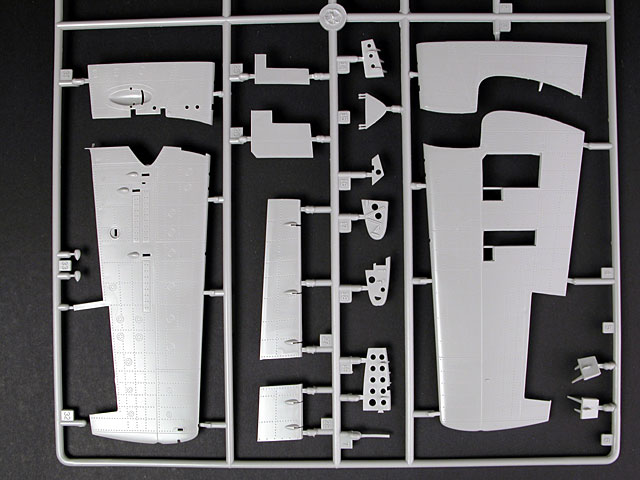
Also, gone are the capsule-like shapes representing fabric
texture on the rudder. These have been replaced with more appropriate raised
horizontal ribs. These can be left as they are, or sanded down according to the
individual modeller's taste
All control surfaces are movable, including the flaps. Each
control surface is connected using a metal rod and photo-etched hinges.
In the first release of the kit, the leading edge of the rudder
was sharply squared off and butted against a flat mating surface on the fin.
This would have almost certainly led to complications of fit and movement. A new
rudder is now supplied, rounded-off along the length of the hinge line. A
corresponding recess on the fin will accommodate the rudder.
The wings folds are also workable. These are hinged via a single
styrene pin inside the wing, so care will be required when handling the model
and operating the wing fold.
The solid cockpit floor has also been replaced with a brand-new
partial floor, with large open areas on each side. This is much more
representative of the real aircraft, and will create an authentic see-through
effect with the windows in the lower fuselage. The cockpit also contains some nicely detailed parts. Quadrants, boxes
and cases are all supplied separately so there is ample potential to complete a superdetailed cockpit without a floor and with some scratchbuilt structural detail
added to
the lower half of the fuselage.
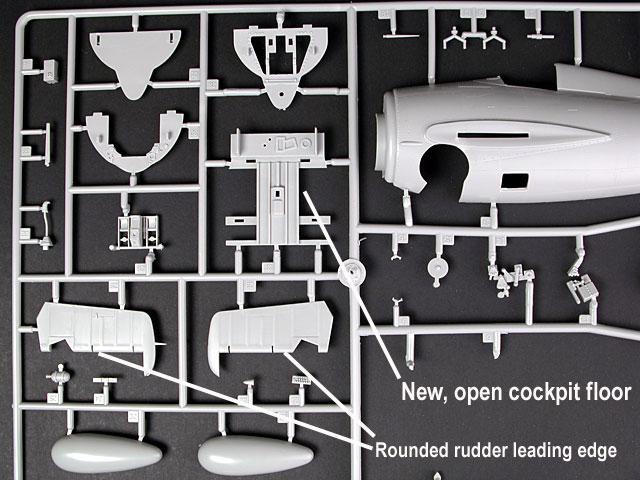
Detail in the engine is not bad, and intercooler intakes have
been slightly lengthened too. Adding wiring detail on the engine will be
worth the effort as it will be quite visible in
this scale.
The transaprent parts are really very good. They are thin and clear.
The shape of the canopy and windscreen, which looked okay the first time around,
have been further refined.

I am pleased to report that all of the major accuracy issues
have been addressed with this re-tooled kit.
Fuselage
The biggest problem with the original version of Trumpeter's
Wildcat was the outline accuracy of the fuselage.
Compared to scaled-up drawings from Bert Kinzey's 2000 edition
of "F4F Wildcat in Detail", there were serious discrepancies around the nose
and spine. The fuselage was also too long, probably due to a misunderstanding
about the correct position of the rudder hinge line of the real aircraft. At
the time I tested the important discrepancies by checking photographs and the
shape of other Wildcat models which, although varying in detail, confirmed the
basic shape problems.
Diagram 1: Comparison of Original Kit
Fuselage with Lloyd Jones' F4F-4 Drawing:
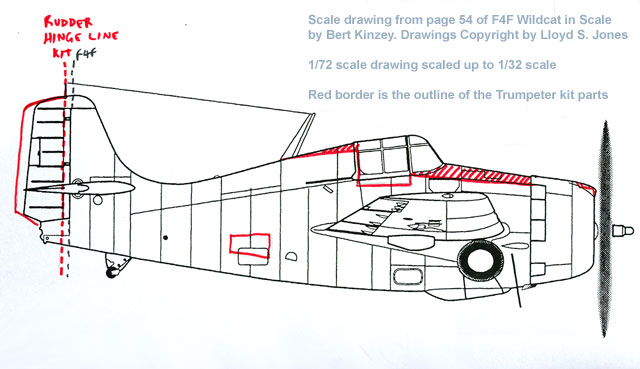
Diagram 2: Comparison of Re-Tooled
Trumpeter Fuselage with Lloyd Jones' F4F-4 Drawing:
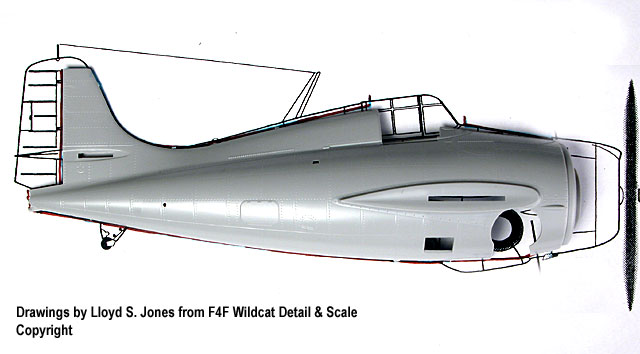
As can be seen, the spine and the nose are now much closer to
the diagram, and the shape and dimensions of the fin conform almost perfectly.
In fact, the minor variations between the Trumpeter fuselage
and these drawings may suggest that the drawing is actually slightly
off.
For further comparison, I measured the Tamiya 1/48 scale F4F-4
Wildcat at two critical areas - the overall height of the fuselage at the top
of the spine (immediately behind the canopy); and the diameter of the back of
the engine cowl. The overall fuselage height of the Tamiya kit was 41mm, and
the cowl diameter was 31mm. I scaled these dimensions up to 1/32 scale by
multiplying by 1.5. There was less than one millimetre difference between the
scaled-up dimensions of the Tamiya kit and the same areas on the re-tooled
Trumpeter kit.
Personally, I think the subtle shapes of the Trumpeter and
Tamiya spines looks closer to photographs than the drawings.
To see how proportionally similar the two kits are, check out
Tamiya's fuselage compared to a 1/48 scale version of the same plans shown
above:
Diagram 3: Comparison of 1/48 Tamiya
Fuselage with Lloyd Jones' F4F-4 Drawing:
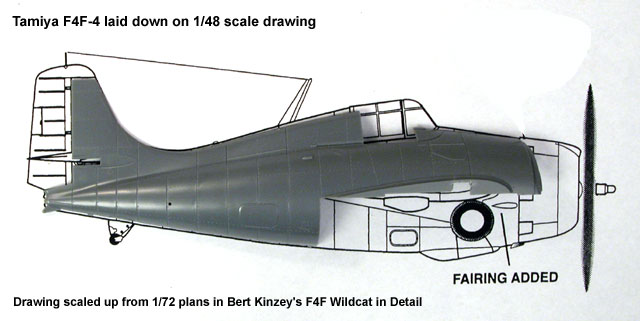
Improvements to the fuselage are summarised below:
-
The rudder hinge line has been
relocated forward, and the width of the tail has been corrected.
-
The mid-fuselage access hatch has
been re-shaped and relocated, and other fuselage details improved (including
the blister fairing).
-
The angle of the fuselage spine has
been increased and straightened. It no longer looks like a Hurricane spine!
Importantly, the contours of the barrel-like fuselage have also been
corrected.
-
The nose has been increased in
height by around 5mm at the front of the windscreen, and the
characteristically steep angle to the engine cowling is now represented very
well. As a result of improvement nos. 3 and 4, the canopy line is now correct
too.
-
The top cowl intake has been rounded
off and angled forward, and the intercooler intakes have been widened and
deepened.
Diagram 4: Old and New Trumpeter 1/32 F4F
Fuselages Compared:
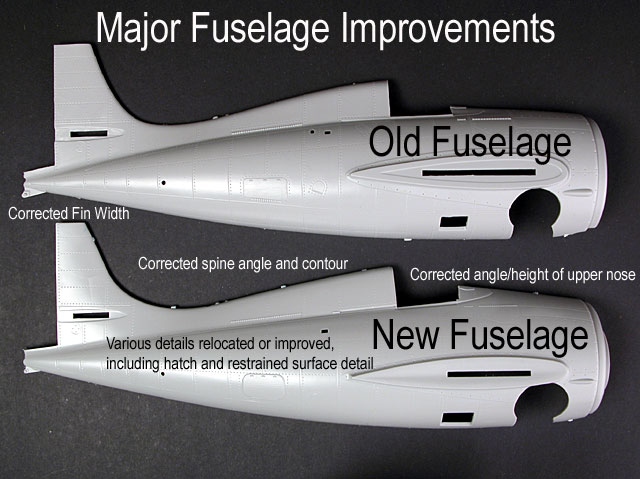
Wings
The wings have also been re-tooled. The earlier version was
too short, had problems with the shape of the wingtips and the location of the
ailerons. All of these issues have been addressed with the re-tooled kit:
Diagram 5: New Trumpeter 1/32 F4F
Outer-Wing Compared to Plan:
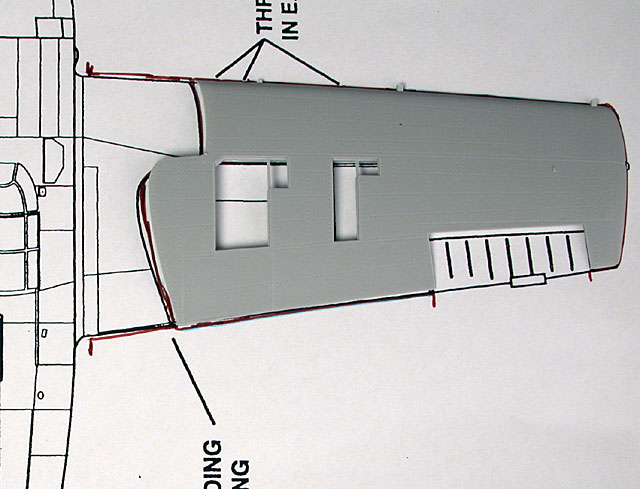
The only left-over problem on this test shot, as far as I can
tell, is the proportionally long cuffs on the propeller blades. It is almost
certain that the after-market will quickly come to the rescue in this
department with resin replacements (wouldn't be surprised to see resin wheels
to replace the rubber parts in the kit too).
The F4F Wildcat was a hugely important aircraft in the Second
World War, and deserves to be well represented in plastic.
Now, Trumpeter has created a replica in 1/32 scale that is
worthy of its famous full-size equivalent.
Trumpeter has taken an unprecedented course in recalling the
original, flawed kit from the brink of release; and retooling virtually all
of the main components plus some important detail parts. This level of
responsiveness and commitment to quality is remarkable.
Trumpeter's 1/32 scale F4F-4 Wildcat appears to be quite
accurate in outline and dimensions, boasts plenty of workable features, pretty
good detail and newly restrained surface features. There is no doubt that the
kit looks like a Wildcat this time around. Its size also makes it an
ideal candidate for superdetailing, especially in the cockpit, engine bay and
wheel wells.
I am pleased to recommend the re-tooled F4F-4 Wildcat without
reservation!
Recommended
Thanks to Trumpeter for the test-shot
Text and Images Copyright © 2003 by
Brett Green
Page Created 12 Septmeber, 2003
Last updated 15 September, 2003
Back to HyperScale Main Page
Back to Reviews Page
|
Home | What's
New | Features
| Gallery |
Reviews | Reference
| Forum
| Search